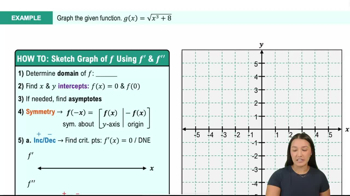Table of contents
- 0. Functions7h 52m
- Introduction to Functions16m
- Piecewise Functions10m
- Properties of Functions9m
- Common Functions1h 8m
- Transformations5m
- Combining Functions27m
- Exponent rules32m
- Exponential Functions28m
- Logarithmic Functions24m
- Properties of Logarithms34m
- Exponential & Logarithmic Equations35m
- Introduction to Trigonometric Functions38m
- Graphs of Trigonometric Functions44m
- Trigonometric Identities47m
- Inverse Trigonometric Functions48m
- 1. Limits and Continuity2h 2m
- 2. Intro to Derivatives1h 33m
- 3. Techniques of Differentiation3h 18m
- 4. Applications of Derivatives2h 38m
- 5. Graphical Applications of Derivatives6h 2m
- 6. Derivatives of Inverse, Exponential, & Logarithmic Functions2h 37m
- 7. Antiderivatives & Indefinite Integrals1h 26m
- 8. Definite Integrals4h 44m
- 9. Graphical Applications of Integrals2h 27m
- 10. Physics Applications of Integrals 2h 22m
5. Graphical Applications of Derivatives
Curve Sketching
Problem 3.6.54b
Textbook Question
{Use of Tech} Fuel economy Suppose you own a fuel-efficient hybrid automobile with a monitor on the dashboard that displays the mileage and gas consumption. The number of miles you can drive with g gallons of gas remaining in the tank on a particular stretch of highway is given by m(g) = 50g−25.8g²+12.5g³−1.6g⁴, for 0≤g≤4.
b. Graph and interpret the gas mileage m(g)/g.
 Verified step by step guidance
Verified step by step guidance1
First, understand the function m(g) = 50g - 25.8g² + 12.5g³ - 1.6g⁴, which represents the number of miles you can drive with g gallons of gas. This is a polynomial function of degree 4.
To find the gas mileage, which is the miles per gallon, you need to calculate m(g)/g. This involves dividing the function m(g) by g, resulting in a new function: m(g)/g = (50g - 25.8g² + 12.5g³ - 1.6g⁴)/g.
Simplify the expression m(g)/g by dividing each term in the polynomial by g. This gives: m(g)/g = 50 - 25.8g + 12.5g² - 1.6g³.
Graph the simplified function m(g)/g = 50 - 25.8g + 12.5g² - 1.6g³ over the interval 0 ≤ g ≤ 4. This graph will show how the gas mileage changes as the amount of gas in the tank varies.
Interpret the graph: Look for key features such as maximum or minimum points, which indicate the most or least efficient gas mileage. Also, observe the overall trend of the graph to understand how gas mileage is affected by the amount of gas remaining.
 Verified video answer for a similar problem:
Verified video answer for a similar problem:This video solution was recommended by our tutors as helpful for the problem above
Video duration:
3mPlay a video:
Was this helpful?
Key Concepts
Here are the essential concepts you must grasp in order to answer the question correctly.
Function Analysis
Understanding the function m(g) is crucial, as it represents the relationship between the gallons of gas remaining and the miles driven. Analyzing this polynomial function involves identifying its behavior, such as its maximum and minimum values, which can be determined through calculus techniques like finding critical points and evaluating the function's limits.
Recommended video:

Derivatives Applied To Velocity
Graphing Rational Functions
To graph the gas mileage m(g)/g, one must understand how to graph rational functions, which are formed by dividing one function by another. This involves determining the domain, identifying asymptotes, and analyzing the behavior of the function as g approaches critical values, such as 0 and 4, to accurately represent the mileage per gallon.
Recommended video:

Graph of Sine and Cosine Function
Interpretation of Graphs
Interpreting the graph of m(g)/g requires understanding what the graph represents in the context of fuel economy. This includes analyzing the shape of the graph to determine efficiency at different gas levels, identifying peaks that indicate optimal mileage, and understanding how changes in gas consumption affect overall performance.
Recommended video:

Graphing The Derivative

 11:41m
11:41mWatch next
Master Summary of Curve Sketching with a bite sized video explanation from Callie
Start learning




